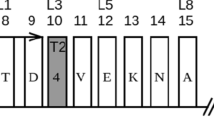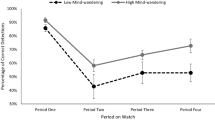Abstract
The dominant theory amongst vigilance researchers is resource theory. From this theoretical perspective the increase in lapses with time on task, the vigilance decrement, is due to the depletion of the cognitive resources necessary for the maintenance of performance. Alternative under-load theories have recently been suggested: mindlessness and goal habituation. Advocates of mindlessness theory suggest the vigilance decrement results from conscious disengagement due to task monotony. From this theoretical perspective, the inclusion of content unrelated cues should draw the participants out of their mindless state. An alternative proposal is that vigilance decrements are a result of goal habituation. From this perspective a momentary deactivation and reactivation of task goal by inserting a brief task switch in a vigilance task should eliminate the vigilance decrement. In order to examine these alternative theories, we had 498 participants perform a visual vigilance task with either the inclusion of brief task switches, content-free cues, or in comparative control conditions during the vigilance task. All experimental groups had an equivalent robust vigilance decrement measured by both a decline in perceptual sensitivity over time and an increase in response latency over time. There was, moreover, no difference in self-reported mental workload or task-unrelated thoughts across the experimental groups. Bayesian analyses resulted in substantial evidence in favour of the null hypothesis, in agreement with the expectations based on resource theory and contrary to the expectations based on either the mindlessness or goal-habituation theories.




Similar content being viewed by others
References
Aiken EG, Lau AW (1967) Response prompting and response confirmation: a review of recent literature. Psych Bull 68:330–341
Annett K, Patterson L (1967) Training for auditory detection. Acta Psychol 27:420–426
Ariga A, Lleras A (2011) Brief and rare mental “breaks” keep you focused: deactivation and reactivation of task goals preempt vigilance decrements. Cognition 118:439–443
Caggiano DM, Parasuraman R (2004) The role of memory representation in the vigilance decrement. Psych Bull Rev 11:932–937
Cheyne JA, Solman GJF, Carriere JSA, Smilek D (2009) Anatomy of an error: a bidirectional state model of task engagement/disengagement and attention-related errors. Cognition 111:98–113
Davies DR, Parasuraman R (1982) The psychology of vigilance. Academic Press, London
Dienes Z (2011) Bayesian versus orthodox statistics: which side are you on? Perspect Psychol Sci 6:274–290
Dockree PM, Kelly SP, Roche RA, Hogan MJ, Reilly RB, Robertson IH (2004) Behavioural and physiological impairments of sustained attention after traumatic brain injury. Cogn Brain Res 20:403–414
Dockree PM, Bellgrove MA, O’Keefe FM, Moloney P, Aimola L, Cartoon S, Robertson IH (2006) Sustained attention in traumatic brain injury (tbi) and healthy controls: enhanced sensitivity with dual-task load. Exp Brain Res 168:218–229
Fan J, McCandliss BD, Fossella J, Flombaum JL, Posner MI (2005) The activation of attention networks. NeuroImage 26:471–479
Gluckman JP, Warm JS, Dember WN, Rosa RR (1993) Demand transitions and sustained attention. J Gen Psychol 120:323–337
Grier RA, Warm JS, Dember WN, Matthews G, Galinsky TL, Szalma JL, Parasuraman R (2003) The vigilance decrement reflects limitations in effortful attention not mindlessness. Hum Factors 45:349–359
Hancock PA, Hart SG (2002) Defeating terrorism: what can human factors/ergonomics offer? Ergonom Design 10:6–16
Hart SG, Staveland LE (1988) Development of NASA-TLX (Task Load Index): results of empirical and theoretical research. In: Hancock PA, Meshkati N (eds) Human mental workload. North-Holland, Amsterdam, pp 139–183
Helton WS (2009) Impulsive responding and the sustained attention to response task. J Clin Exp Neuropsyc 31:39–47
Helton WS, Russell PN (2011a) The effects of arousing negative and neutral picture stimuli on target detection in a vigilance task. Hum Factors 53:132–141
Helton WS, Russell PN (2011b) Working memory load and the vigilance decrement. Exp Brain Res 212:429–437
Helton WS, Warm JS (2008) Signal salience and the mindlessness theory of vigilance. Acta Psychol 129:18–25
Helton WS, Dember WN, Warms JS, Matthews G (2000) Optimism, pessimism, and false failure feedback: effects on vigilance performance. Curr Psychol 18:311–325
Helton WS, Hollander TD, Warm JS, Matthews G, Dember WN, Wallart M, Beauchamp G, Parasuraman R, Hancock PA (2005) Signal regularity and the mindlessness model of vigilance. Br J Psychol 96:249–261
Helton WS, Hollander TD, Tripp LD, Parsons K, Warm JS, Matthews G et al (2007) Cerebral hemodynamics and vigilance performance. J Clin Exp Neuropsychol 29:545–552
Helton WS, Dorahy MJ, Russell PN (2011a) Dissociative tendencies and right hemisphere processing load: effects on vigilance performance. Conscious Cogn 20:696–702
Helton WS, Head J, Russell PN (2011b) Reliable and unreliable warning cues in the sustained attention to response task. Exp Brain Res 209:401–407
Hitchcock EM, Dember WN, Warm JS, Maroney BW, See J (1999) Effects of cueing and knowledge of results on workload and boredom in sustained attention. Hum Factors 41:365–372
Hitchcock EM, Warm JS, Matthews G, Dember WN, Shear PK, Tripp LD, Mayleben DW, Parasuraman R (2003) Automation cueing modulates cerebral blood flow and vigilance in a simulated air traffic control task. Theoret Issues Ergono Sci 4:89–112
Lim J, Wu W, Wang J, Detre JA, Dinges DF, Rao H (2010) Imaging brain fatigue from sustained mental workload: an ASL perfusion study of the time-on-task effect. NeuroImage 49:3426–3435
Mackworth NH (1948) The breakdown of vigilance during prolonged visual search. Q J Exp Psychol 1:6–21
Mackworth NH (1950) Researches on the measurement of human performance. Medical research council special report, No. 2680. London: H.M.S.O. (Reprinted from Selected papers in the design and use of control systems, pp 174–331 by HW Sinaiko Ed., 1961, New York: Dover)
Mackworth JF (1968) Vigilance, arousal, and habituation. Psychol Rev 75:308–322
MacLean KA, Aichele SR, Bridwell DA, Mangun GR, Wojciulik E, Saron CD (2009) Interactions between endogenous and exogenous attention during vigilance. Atten Percept Psychophys 71:1042–1058
Macmillan NA, Creelman CD (2005) Detection theory: a user’s guide. Erlbaum, Mahwah, NJ
Manly T, Robertson IH, Galloway M, Hawkins K (1999) The absent mind: further investigations of sustained attention to response. Neuropsychologia 37:661–670
Manly T, Heutlink J, Davidson B, Gaynord B, Greenfield E, Parr A, Ridgeway V, Robertson IH (2004) An electronic knot in the hankerchief: content free cueing and the maintenance of attentive control. Neuropsychol Rehabil 14:89–116
Matthews G, Davies DR, Westerman SJ, Stammers RB (2000) Human performance: cognition, stress and individual differences. Psychology Press, East Sussex
Matthews G, Campbell SE, Falconer S, Joyner LA, Huggins J, Gilliand K (2002) Fundamental dimensions of subjective state in performance settings: task engagement, distress, and worry. Emot 2:315–340
Matthews G, Warm JS, Reinerman-Jones LE, Washburn DA, Tripp LD (2010) Task engagement, cerebral blood flow velocity, and diagnostic monitoring for sustained attention. J Exp Psychol Appl 16:187–203
Maxwell SE, Delaney HD (2004) Designing experiments and analyzing data: a model comparison perspective, 2nd edn. Erlbaum, Mahwah, NJ
O’Connell RG, Bellgrove MA, Dockree PM, Robertson IA (2006) Cognitive remediation in ADHD: effects of periodic non-contingent alerts on sustained attention to response. Neuropsychol Rehabil 16:653–665
O’Connor C, Robertson IH, Levine B (2011) The prosthetics of vigilant attention: random cuing cuts processing demands. Neuropsychol 25:1–9
Ossowski U, Malinen S, Helton WS (2011) The effects of emotional stimuli on target detection: indirect and direct resource costs. Conscious Cogn 20:1649–1658
Parasuraman R (1979) Memory load and event rate control sensitivity decrements in sustained attention. Science 205:924–927
Robertson IH, Manly T, Andrade J, Baddeley BT, Yiend J (1997) “Oops!”: performance correlates of everyday attentional failures in traumatic brain injured and normal subjects. Neuropsychologia 35:747–758
Rouder JN, Speckman PL, Sun D, Morey RD, Iverson G (2009) Bayesian t tests for accepting and rejecting the null hypothesis. Psych Bull Rev 16:225–237
Sarason IG, Sarason BR, Keefe DE, Hayes BE, Shearine E (1986) Cognitive interference: situational determinants and traitlike characteristics. J Pers Soc Psychol 51:215–226
See JE, Howe SR, Warm JS, Dember WN (1995) A meta-analysis of the sensitivity decrement in vigilance. Psychol Bull 117:230–249
Seli P, Cheyne JA, Smilek D (2012) Attention failures versus misplaced diligence: separating attention lapses from speed-accuracy tradeoffs. Conscious Cogn 21:277–291
Shaw TH, Warm JS, Finomore V, Tripp L, Matthews G, Weiler E, Parasuraman R (2009) Effects of sensory modality on cerebral blood flow velocity during vigilance. Neurosci Lett 461:207–211
Shaw TH, Finomore V, Warm JS, Matthews G (2012) Effects of regular and irregular event schedules on cerebral hemovelocity during a sustained attention task. J Clin Exp Neuropsychol 34:57–66
Temple JG, Warm JS, Dember WN, Jones KS, LaGrange CM, Matthews G (2000) The effects of signal salience and caffeine on performance, workload and stress in an abbreviated vigilance task. Hum Factors 42:183–194
Thompson RF (2009) Habituation: a history. Neurobiol Learn Mem 92:127–134
Thompson RF, Spencer WA (1966) Habituation: a model phenomenon for the study of neuronal substrates of behavior. Psychol Rev 73:16–43
Turatto M, Galfano G (2000) Color, form and luminance capture attention in visual search. Vision Res 40:1639–1643
Warm JS (1984) An introduction to vigilance. In: Warm JS (ed) Sustained attention in human performance. Wiley, Chichester, pp 1–14
Warm JS (1993) Vigilance and target detection. In: Huey BM, Wickens CD (eds) Workload transitions: implications for individual and team performance. National Academy Press, Washington, DC, pp 139–170
Warm JS, Parasuraman R, Matthews G (2008) Vigilance requires hard mental work and is stressful. Hum Factors 50:433–441
Weiner EL, Attwood DA (1968) Training for vigilance: combined cueing and knowledge of results. J Appl Psychol 52:474–479
Author information
Authors and Affiliations
Corresponding author
Rights and permissions
About this article
Cite this article
Helton, W.S., Russell, P.N. Brief mental breaks and content-free cues may not keep you focused. Exp Brain Res 219, 37–46 (2012). https://doi.org/10.1007/s00221-012-3065-0
Received:
Accepted:
Published:
Issue Date:
DOI: https://doi.org/10.1007/s00221-012-3065-0




